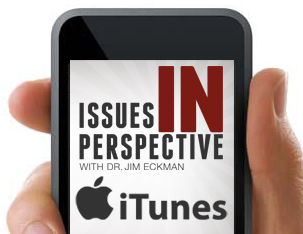Thinking Critically And Biblically About Identity Politics And The D.E.I Monoculture
Jan 4th, 2025 | By Dr. Jim Eckman | Category: Culture & Wordview, Featured IssuesThe mission of Issues in Perspective is to provide thoughtful, historical and biblically-centered perspectives on current ethical and cultural issues.

Over the last several decades, Americans, it has been argued, are more tribal in their behavior and social groupings than ever. We live in silos of our own choice, watch cable news channels or listen to podcasts that simply reinforce our tribal identities. We are not open to new ideas and are threatened by those who are not in our silos. In this cultural development, the individual is not as important. Our group identity defines us and we are not open to those outside our groupings. How did this develop within American civilization? What are its origins?
Columnist David Brooks, recently converted to Christianity, argues that “Over the past few generations, a certain worldview that emphasizes racial, gender and ethnic identity has been prevalent in the circles where highly educated people congregate. This worldview emerged from . . . liberation movements that highlighted American life over the past seven decades: the civil rights movement, the women’s liberation movement, the gay rights movement, the trans rights movement. The crucial assertion of the identitarian mind-set is that all politics and all history can be seen through the lens of liberation movements. Society is divided between the privileged (straight white males) and the marginalized (pretty much everyone else). History and politics are the struggle between oppressors and oppressed groups.” Such a worldview has several important consequences:
- “In this model, people are seen as members of a group before they are seen as individuals. When Biden picked his running mate in 2020, he had promised to pick a woman, and when he picked his Supreme Court nominee in 2022, he had promised to pick a Black woman. In both cases her identity grouping came before her individual qualities.”
- “In this model, society is seen as an agglomeration of different communities. Democrats thus produce separate agendas designed to mobilize Black men, women and so on. The goal of Democratic politics is to link all the oppressed and marginalized groups into one majority coalition.”
- “In this model, individual cognition is de-emphasized while collective consciousness is emphasized. Groups are assumed to be relatively homogeneous. People are seen as representatives of their community . . . This is the idea that a person’s ideas are primarily shaped not by individual preferences but by the experience of the group . . . a person’s thoughts are assumed to be dispatches from a communal experience. “
Thus, in an individualistic age, it gives people a sense of membership in a group. It helps them organize their lives around a noble cause, fighting oppression. But, Brooks argues, “this mind-set has just crashed against the rocks of reality. This model assumes that people are primarily motivated by identity group solidarity. This model assumes that the struggle against oppressive systems and groups is the central subject of politics. This model has no room for what just happened. It turns out a lot of people don’t behave like ambassadors from this or that group. They think for themselves in unexpected ways. It turns out that many people don’t see politics and history through the paradigm of liberation movements. They are concerned with all kinds of issues that don’t fit into the good-versus-evil mind-set of oppressor versus oppressed.”
Furthermore, people are exhausted by the crude generalizations that are so common today. A lot of the group categories that identity politics rely on don’t make much sense. Brooks identifies a few:
- Analysts talk about gender wars and hypermasculine Trump supporters. But in most elections, as in the 2024 election, there’s not a vast difference between how men and women vote. The differences within the male and female populations are greater than the differences between these populations.
- A lot of the group categories that identity politics rely on don’t make much sense. For example, the category “Hispanic voter” includes people of Mexican descent whose families have been in Texas for 350 years as well as families from Chile who came to New York a decade ago.
- The category “people of color” doesn’t make sense, either, as a way to group individuals as a political force. America has been uniquely wretched to Black Americans, practicing structural racism that shows up today, for example, in the horrendous wealth gap between Black and white people. The diverse communities we call Asian and Hispanic Americans came here largely voluntarily. Many of them have been able to prosper and experience educational and income trajectories that are different from those of a community that has suffered hundreds of years of slavery and discrimination.
- Even the most solid identity group categories are fluid. As a recent Pew Research Center study found, among people who married in 2022, 32 percent of Asian Americans married outside their ethnic group, as did 30 percent of Hispanics, 23 percent of Black people and 15 percent of white people. In one Pew survey 58 percent of Hispanics also identified as white.
Evangelical attorney and columnist David French addresses another aspect of identitarianism, namely the D.E.I. (diversity, equity, inclusion) cultural phenomenon. He cites Nicholas Confessore’s masterful and comprehensive report in The New York Times Magazine on the failure of the University of Michigan’s huge investment in D.E.I. The Michigan campus D.E.I. bureaucracy was attempting to address an almost impossibly difficult and important task from within an ideological monoculture. It was doomed to fail—in toxic ways.
There are two troubling components to his story.
- The first is found in the bottom-line results of the university’s D.E.I. program. In spite of spending staggering sums of money, hiring scores of diversity administrators and promulgating countless new policies, the efforts failed. Michigan still hasn’t come close to becoming as diverse as it wants to be. Black students, for example, are stuck at around 4 to 5 percent of the undergraduate population in a state where 14 percent of the residents are Black.
- The second is that those ineffective policies were promulgated and enforced in part through a campus culture that was remarkably intolerant. Confessore’s report is replete with examples of professors who faced frivolous complaints of race or gender bias, and after Hamas’s terrorist attack on Oct. 7—when the university’s commitments to pluralism were put to their toughest test—Michigan couldn’t meet even its most basic legal obligations.
“In a June news release announcing the resolution of two civil rights complaints against the university for antisemitism, the U.S. Department of Education said that it “found no evidence that the university complied with its Title VI requirements to assess whether incidents individually or cumulatively created a hostile environment for students, faculty or staff.” The school also did not “take steps reasonably calculated to end the hostile environment, remedy its effects and prevent its recurrence.” In spite of immense expenditures intended to foster a climate of inclusion on campus, Jewish students could not even count on their school to comply with the law. The school couldn’t cross the lowest possible bar of acceptable behavior.” Why? Because it’s full of human beings.
French makes this astute observation: “It’s a fact of human nature that when like-minded people gather, they tend to become more extreme. This concept—called the law of group polarization—applies across ideological and institutional lines. The term was most clearly defined and popularized in a 1999 paper by Cass Sunstein. The law of group polarization, according to Sunstein, ‘helps to explain extremism, ‘radicalization,’ cultural shifts and the behavior of political parties and religious organizations’. . . The university’s vast D.E.I. bureaucracy seemed uninterested in one of the most critical aspects of diversity—the diversity of ideas. Michigan’s D.E.I. bureaucracy could even take issue with the idea that ‘students should be expected to encounter uncomfortable ideas.’”
In 1959 the British jurist Patrick Devlin made a point that should haunt us: “Without shared ideas on politics, morals and ethics, no society can exist.” He added, “If men and women try to create a society in which there is no fundamental agreement about good and evil, they will fail; if having based it on common agreement, the agreement goes, the society will disintegrate.” Therefore, “We need a social vision that is as morally compelling as identity politics but does a better job of describing reality. We need a national narrative that points us to some ideal and gives each of us a noble role in pursuing it.”
There is only one way to settle the D.E.I. ideological monoculture and the bankruptcy of identitarianism—seeing ourselves as God sees us. There are two aspects of our new identity in Christ:
(1) As humans, we are created in the image of God, which establishes our infinite worth and value. It is the baseline for the value of humanity at every stage in development. This weighty truth establishes one aspect of our identity: We both resemble God (in His communicable attributes—intellect, emotion and will), and we represent Him as dominion stewards of His world.
(2) The Bible also makes clear that when we place our faith in Christ’s finished work on Calvary’s cross and His subsequent resurrection, we are a “new creation, the old has gone, the new has come” (2 Corinthians 5:17). Our new identity is that we are “in Christ,” a powerful and profound phrase used 242 times in the New Testament. The power of sin and the power of death have been broken (see Romans 6). When we place our faith in Christ, we are declared righteous by Almighty God (justification): Christ’s righteousness has been imputed to our account. Further, we are adopted into God’s family, with all the rights and privileges of being a joint heir with Christ (see Galatians 4 and Romans 8). God is now our heavenly Father and we are His children. We await the wondrous family gathering of all the brothers and sisters of God’s family in His coming kingdom. Finally, we are being transformed into the image of Christ (Galatians 4:19, Romans 8:29). We now belong to Jesus, who bought us with the price of His shed blood and we are indwelt by His Spirit (1 Corinthian 6:19). Galatians 2:20 perhaps best summarizes our new identity in Christ: “I have been crucified with Christ and I no longer live, but Christ lives in me. The life I live in the body, I live by faith in the Son of God, who loved me and gave himself for me.” The struggles, tensions and confusion about personal identity in this world are resolved in Jesus Christ. To be “in Christ” is the vital center of a new identity offered by God. As with all things in this broken world, the Gospel is the answer. Who am I in Christ? I am accepted; I am secure; and I am significant. My identity comes from what God says about who I am and by what God has done for me through Jesus.
See David Brooks in the New York Times (15 November 2024) and David French in the New York Times (21 October 2024).


